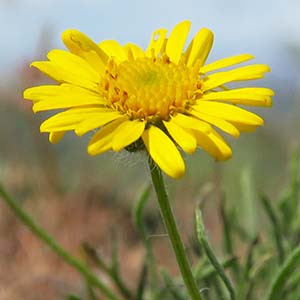|
Eaton's fleabane
|
Piper's fleabane
|
| Perennial from a tap-root, 5-30 cm. tall, the stems decumbent and purplish at the base, with appressed hairs. |
Perennial from a taproot and short, branched, woody base, the stem 3-10 cm. high and covered with short, stiff appressed hairs. |
Basal leaves tufted, narrow, acute, gradually tapering to the petiole; cauline leaves several, conspicuously reduced. |
Leaves mostly basal or lower-cauline, linear, lax and curved, up to 4 cm. long and 1.5 mm. wide, with short, stiff, sharp-pointed hairs on the margins and appressed- hairy on the surfaces, the lower leaves with conspicuously enlarged, hardened, whitish bases. |
Heads solitary or up to 7 in an open inflorescence; involucres 5-7 mm. high; rays 20-50, pistillate, white, 5-10 mm. long and 1-3 mm. wide; disk corollas 3.5-5 mm. long, yellow; inner pappus bristles 15-20, outer obscure. |
Heads solitary or few, small, the disk 5-10 mm. wide; involucre 3-5 mm. high, covered with long, white, stiff, spreading hairs; rays 25-40, pistillate, yellow, 4-9 mm. long and 1.0-1.8 mm. wide; disk corollas 2.8-4.2 mm. long, yellow; pappus of 15-25 capillary bristles. |
|
|
|
|
| May-July |
May-June |
| Grasslands, sagebrush, dry slopes, and forest openings at low to middle elevations. |
Dry, open places, often in sandy soil among sagebrush. |
Occurring east of the Cascades crest in central and southeastern Washington; central Washington to California, east to the Rocky Mountains.
|
Endemic to Washington, where occurring east of the Cascades crest from north-central to south-central Washington.
|
| Native |
Native |
| Not of concern |
Not of concern |
E. acris, E. aliceae, E. annuus, E. aureus, E. basalticus, E. bloomeri, E. caespitosus, E. chrysopsidis, E. compositus, E. corymbosus, E. davisii, E. disparipilus, E. divergens, E. elatus, E. filifolius, E. flettii, E. glacialis, E. howellii, E. inornatus, E. karvinskianus, E. leibergii, E. linearis, E. lonchophyllus, E. nivalis, E. oreganus, E. peregrinus, E. philadelphicus, E. piperianus, E. poliospermus, E. pumilus, E. salishii, E. speciosus, E. strigosus, E. subtrinervis |
E. acris, E. aliceae, E. annuus, E. aureus, E. basalticus, E. bloomeri, E. caespitosus, E. chrysopsidis, E. compositus, E. corymbosus, E. davisii, E. disparipilus, E. divergens, E. eatonii, E. elatus, E. filifolius, E. flettii, E. glacialis, E. howellii, E. inornatus, E. karvinskianus, E. leibergii, E. linearis, E. lonchophyllus, E. nivalis, E. oreganus, E. peregrinus, E. philadelphicus, E. poliospermus, E. pumilus, E. salishii, E. speciosus, E. strigosus, E. subtrinervis |
|
|
| |



